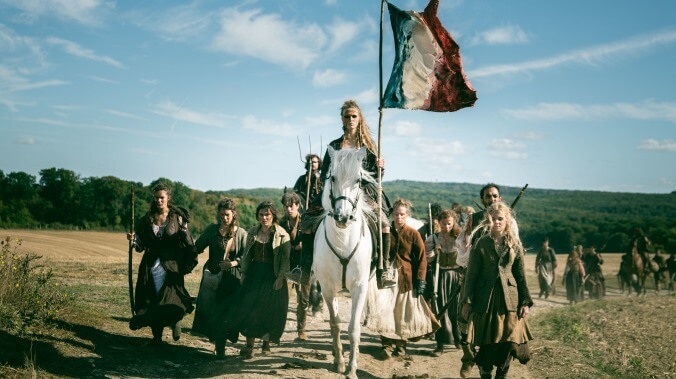La Révolution is more interested in nationalist feel-good stories than the French Revolution


Netflix’s new historical drama La Révolution, an eight-hour series directed by Aurélien Molas, doesn’t so much bend history as it snaps it across its knee, fashioning its pieces into a bonfire around which to tell nationalist feel-good fairy tales and ghost stories. La Révolution is not about the French Revolution but rather, the idea of the French Revolution. And while that description itself might come across as pedantic on its face, when we’re talking about a series that ostensibly centers around one of the most anarchic, consequential, and fiercely debated revolutions in human history, the distinction between historical events and how they’re remembered bears vital importance.
While the majority of the series is set in and around the French county of Montagris in 1787, two years before and approximately 80 miles away from the site of the formal beginning of the revolution, La Révolution’s opening scene jumps forward in time to offer us a peek at the carnage to come. “It is said that history is written by the winners. It is forgotten that it is rewritten over time,” a young girl’s voice tells us as the camera surveys the desolation of what we can only presume is Paris in the year 1789. “Transformed by books. Reinvented by those who didn’t live through it.” As we watch this same girl (played by Amélia Lacquemant), strutting astride a blood-drenched pale horse through an apocalyptic winter landscape before decapitating a nobleman with a machete, a rich blue geyser of blood spilling out from his neck, she tells us that her name is Madeleine de Montargis and that what follows is a testament “on how the century of darkness became that of enlightenment.” You know, barring that whole “Reign Of Terror” business and the rise of Napoleonic authoritarianism and all that—but yeah, sure, enlightenment!
This sets the tone for La Révolution’s entire approach and understanding of French Revolution. Which is to say, a reductionist reading that takes all the complicated nuances of an era and distills them into a piece of contemporary revisionist agitprop crammed into an ill-fitting premise of pseudo-vampire speculative fiction that’s much too small for its own loftily pronounced ambitions. (But at least the fight scenes are cool.)
While La Révolution touts a broad cast of characters, the series predominantly centers on Élise de Montargis (Marilou Aussilloux), a noblewoman and countess who nurtures sympathies for the peasantry’s plight under the indifferent tyranny of the aristocracy, and Joseph-Ignace Guillotin (Amir El Kacem), a physician with a fierce sense of justice and the future namesake of of the most infamous implement of execution during the revolution. While investigating a series of mysterious murders and disappearances plaguing Montagris, Joseph inadvertently discovers a mysterious virus that’s somehow connected to the true culprit. As he draws closer to the terrible truth behind the disease, both his and Élise’s lives are entangled in a conspiracy of supernatural implications whose discovery will mark the end of an era and the beginning of a revolution.
American viewers will recognize few if any of the main actors here, with the possible exception of Laurent Lucas, who previously starred in Julia Ducournau’s 2016 cannibal horror-drama Raw and here plays the role of Élise’s villainous uncle, Charles de Montargis. The series’ weaknesses lie not with the capable cast, but in its writing. “The nobles represent one percent, and yet they command 93% of all riches,” Joseph’s assistant Katell (Isabel Aimé González-Sola) tells him while attempting to track down a lead on the mysterious affliction that’s plaguing Montagris. These kinds of lines make wholly transparent the overall intentions of the show’s producers. It’s historical allegory at its most superficial, a fantasy designed to self-satisfyingly gesture at the egregious wealth disparity of our own time with little other commentary or parallels to speak of when it comes to the lived experiences and complexities of the era in which it is set.
The main divergence point between La Révolution and its historical namesake involves Louis XVI, who, rather than convene the Estates General assembly to devise a legislative solution to the insurrectionist tensions stoked by the simultaneous crises of mass starvation and a crippling national debt, plots to sire an immortal caste of noblemen through occult blood transfusions to ensure the perpetual reign of the Ancien Régime. This affliction of immortality is evidenced through the literal presence of blue blood, transforming the aristocratic euphemism into a symptom of pseudo-vampirism that comes with heightened sense, superhuman strength, and a near-imperviousness to fatal injury at the cost of an insatiable hunger for human flesh. In La Révolution, the rich are literally eating the poor.
Aside from taking the complicated legacy of a monarch—who was in way over his head, right up to the point it got chopped off—and turning him into a dandily dressed Sith Lord in a powdered wig with Nosferatu nails, La Révolution takes several other liberties with its ostensible inspiration. You won’t hear any mention of either Robespierre or Marquis de Lafayette, but you’ll hear a whole lot about Albert Guillotin, the handsome peasant turned abolitionist turned immortal freedom fighter played by Lionel Erdogan, who serves as Élise’s principal love interest. There’s nothing on the National Assembly, or the Girondins, or the Jacobins, but you’ll see the Fraternity, a homogenous group of nondescript revolutionaries coded in the aforementioned groups’ combined likeness, which presumably serves as the series’ retconned origin story for the French Republic’s motto, originally coined by Robespierre in 1790.
While La Révolution fails in its reimagining of French history, it at least succeeds in its production quality. With a rotating trio of cinematographers (Mathieu Plainfossé, Martial Schmeltz, and Antoine Sanier), the series is admittedly very easy on eyes, with picturesque views of chateau estates, congested squalid streets rife with detritus and beggars, and fog-laden marshes of evergreen treetops. There are some particularly memorable moments when it comes to the show’s aforementioned fight sequences, with Albert beating an entire throng of smugglers in combat or a gendarmerie soldier thrashing atop a galloping horse while coated in flames. The show’s score, composed by French electronic musician Pierre Lefeuvre (aka “Saycet”), is as anachronistic as the series with its lavish fusion of violin arrangements supported by a bed of subtly roiling electronic synths.
If the show didn’t traffic in the iconography of the French Revolution, La Révolution would be an entertaining and competent, if wholly conventional, series of zombie-adjacent horror fiction. But when and where it attempts to whittle the thorny shape of history into something that’s more palatable for contemporary audiences, the series runs aground.
La Révolution offers an emphatically broad and scrupulously sanitized reading of history that champions the ideals of a revolution with little concern for its material context or mortal consequences. The French Revolution was a period of major social upheaval that established a precedent for representational, democratic government and Enlightenment era ideals, such as the separation between church and state throughout Europe and the rest the world. It was also a decade-spanning period of violent coups and counter-coups that marked the transition of one form of authoritarian government to another, slightly different form of authoritarian government. To tell a story, even a fantasy, that purposely omits either of these evident truths is not only disingenuous, but disrespectful in its tacit choice to frame history as an unimpeded arc of upward moral progress that just so happens to be built atop the graves of the countless lives lost along the way.